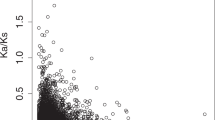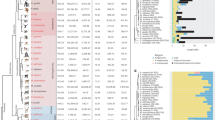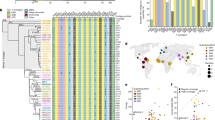Abstract
Mammalian X and Y chromosomes evolved from an autosomal pair; the X retained and the Y gradually lost most ancestral genes1,2. In females, one X chromosome is silenced by X inactivation, a process that is often assumed to have evolved on a broadly regional or chromosomal basis3. Here we propose that genes or clusters common to both the X and Y chromosomes (X–Y genes) evolved independently along a multistep path, eventually acquiring dosage compensation on the X chromosome. Three genes studied here, and other extant genes, appear to be intermediates. ZFX, RPS4 and SMC were monitored for X inactivation in diverse species by assaying CpG-island methylation, which mirrors X inactivation in many eutherians. ZF evidently escaped X inactivation in proto-eutherians, which also possessed a very similar Y-linked gene; both characteristics were retained in most extant orders, but not in myomorph rodents. For RPS4, escape from X inactivation seems unique to primates. SMC escapes inactivation in primates and myomorphs but not in several other lineages. Thus, X inactivation can evolve independently for each of these genes. We propose that it is an adaptation to the decay of a homologous, Y-linked gene.
This is a preview of subscription content, access via your institution
Access options
Subscribe to this journal
Receive 51 print issues and online access
$199.00 per year
only $3.90 per issue
Buy this article
- Purchase on Springer Link
- Instant access to full article PDF
Prices may be subject to local taxes which are calculated during checkout




Similar content being viewed by others
References
Ohno, S. Sex Chromosomes and Sex-linked Genes(Springer, Berlin, (1967)).
Graves, J. A. & Schmidt, M. M. Mammalian sex chromosomes: design or accident? Curr. Opin. Genet. Dev. 2, 890–901 (1992).
Lyon, M. F. Evolution of X-chromosome inactivation in mammals. Nature 250, 651–653 (1974).
Disteche, C. M. The great escape. Am. J. Hum. Genet. 60, 1312–1315 (1997).
Cross, S. H. & Bird, A. P. CpG islands and genes. Curr. Opin. Genet. Dev. 5, 309–314 (1995).
Tribioli, C.et al. Methylation and sequence analysis around Eag I sites: identification of 28 new CpG islands in Xq24-Xq28. Nucl. Acids Res. 20, 727–733 (1992).
Migeon, B. R.et al. Adrenoleukodystrophy: evidence for X linkage, inactivation, and selection favoring the mutant allele in heterozygous cells. Proc. Natl Acad. Sci. USA 78, 5066–5070 (1981).
Brown, C. J., Carrel, L. & Willard, H. F. Expression of genes from the human active and inactive X chromosomes. Am. J. Hum. Genet. 60, 1333–1343 (1997).
Schneider-Gädicke, A., Beer-Romero, P., Brown, L. G., Nussbaum, R. & Page, D. C. ZF has a gene structure similar to ZFY, the putative human sex determinant, and escapes X inactivation. Cell 57, 1247–1258 (1989).
Luoh, S. W.et al. CpG islands in human ZF and ZFY and mouse Zf genes: sequence similarities and methylation differences. Genomics 29, 353–363 (1995).
Ashworth, A., Rastan, S., Lovell-Badge, R. & Kay, G. X-chromosome inactivation may explain the difference in viability of XO humans and mice. Nature 351, 406–408 (1991).
Adler, D. A., Bressler, S. L., Chapman, V. M., Page, D. C. & Disteche, C. M. Inactivation of the Zf gene on the mouse X chromosome. Proc. Natl Acad. Sci. USA 88, 4592–4595 (1991).
Fisher, E. M.et al. Homologous ribosomal protein genes on the human X and Y chromosomes: escape from X inactivation and possible implications for Turner syndrome. Cell 63, 1205–1218 (1990).
Zinn, A. R.et al. Inactivation of the Rps4 gene on the mouse X chromosome. Genomics 11, 1097–1101 (1991).
Aguinik, A. I.et al. Anovel X gene with a widely transcribed Y-linked homologue escapes X-inactivation in mouse and human. Hum. Mol. Genet. 3, 879–884 (1994).
Wu, J.et al. Isolation and characterization of XE169, a novel human gene that escapes X-inactivation. Hum. Mol. Genet. 3, 153–160 (1994).
Wu, J.et al. The murine Xe169 gene escapes X-inactivation like its human homologue. Nature Genet. 7, 491–496 (1994).
Charlesworth, B. The evolution of chromosomal sex determination and dosage compensation. Curr. Biol. 6, 149–162 (1996).
Rice, W. R. Evolution of the Y sex chromosome in animals. BioScience 46, 331–343 (1996).
Aguinik, A. I., Mitchell, M. J., Lerner, J. L., Woods, D. R. & Bishop, C. E. Amouse Y chromosome gene encoded by a region essential for spermatogenesis and expression of male-specific minor histocompatibility antigens. Hum. Mol. Genet. 3, 873–878 (1994).
Mahaffey, C. L.et al. Intron/exon structure confirms that mouse Zfy1 and Zfy2 are members of the ZFY gene family. Genomics 41, 123–127 (1997).
Omoe, K. & Endo, A. Relationship between the monosomy X phenotype and Y-linked ribosomal protein S4 (Rps4) in several species of mammals: a molecular evolutionary analysis of Rps4 homologs. Genomics 31, 44–50 (1996).
Muller, H. J. Evidence of the precision of genetic adaptation. Harvey Lect. 43, 165–229 (1950).
Adler, D. A.et al. Evidence of evolutionary up-regulation of the single active X chromosome in mammals based on Clc4 expression levels in Mus spretus and Mus musculus. Proc. Natl Acad. Sci. USA 94, 9244–9248 (1997).
Goldman, M. A. The chromatin domain as a unit of gene regulation. BioEssays 9, 50–55 (1988).
Page, D. C.et al. The sex-determining region of the human Y chromosome encodes a finger protein. Cell 51, 1091–1104 (1987).
Lovett, M., Kere, J. & Hinton, L. M. Direct selection: a method for the isolation of cDNAs encoded by large genomic regions. Proc. Natl Acad. Sci. USA 88, 9628–9632 (1991).
Novacek, M. J. Mammalian phylogeny: shaking the tree. Nature 356, 121–125 (1992).
Sinclair, A. H.et al. Sequences homologous to ZFY, a candidate human sex-determining gene, are autosomal in marsupials. Nature 336, 780–783 (1988).
D'Esposito, M.et al. Asynaptobrevin-like gene in the Xq28 pseudoautosomal region undergoes X inactivation. Nature Genet. 13, 227–229 (1996).
Acknowledgements
We thank the New England Aquarium, the San Diego Zoo, the Duke Primate Center, K. Fredga and K. Campbell for help in obtaining animal specimens; A. Agulnik for a mouse Smc cDNA clone; D. Graur and B. Lahn for helpful discussions; J. Graves for permission to cite unpublished work; J.Cook-Chrysos for graphic art; and D. Bartel, B. Charlesworth, A. Chess, C. Disteche, G. Fink, J. Graves, R. Jaenisch, T. Kawaguchi, M. L. Pardue, D. Schlessinger, C. Sun, H. Willard and A. Zinn for comments on the manuscript. This work was supported by the National Institutes of Health and the Howard Hughes Medical Institute.
Author information
Authors and Affiliations
Corresponding author
Rights and permissions
About this article
Cite this article
Jegalian, K., Page, D. A proposed path by which genes common to mammalian X and Y chromosomes evolve to become X inactivated. Nature 394, 776–780 (1998). https://doi.org/10.1038/29522
Received:
Accepted:
Issue Date:
DOI: https://doi.org/10.1038/29522
This article is cited by
-
In vitro production of desired sex ovine embryos modulating polarity of oocytes for sex-specific sperm binding during fertilization
Scientific Reports (2022)
-
Differential transcriptome dynamics during the onset of conceptus elongation and between female and male porcine embryos
BMC Genomics (2019)
-
PRC2 represses transcribed genes on the imprinted inactive X chromosome in mice
Genome Biology (2017)
-
X chromosome regulation: diverse patterns in development, tissues and disease
Nature Reviews Genetics (2014)
-
Mammalian Y chromosomes retain widely expressed dosage-sensitive regulators
Nature (2014)
Comments
By submitting a comment you agree to abide by our Terms and Community Guidelines. If you find something abusive or that does not comply with our terms or guidelines please flag it as inappropriate.



